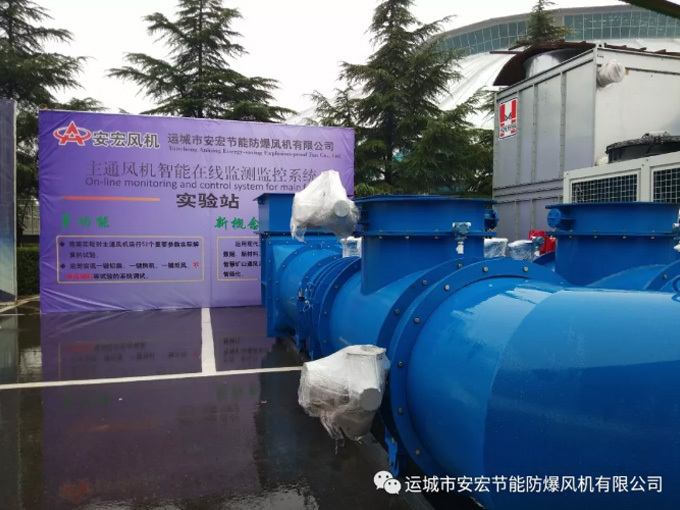How to select explosion-proof fans?
2020-05-19
Explosion-proof fans are used in locations with flammable and explosive gases to prevent accidents caused by flammable and explosive materials. Explosion-proof fans are widely used in factories, mines, tunnels, cooling towers, vehicles, ships, and buildings for ventilation, dust removal, and cooling; ventilation and induced draft for boilers and industrial kilns; cooling and ventilation in air conditioning equipment and household appliances; grain drying and conveying; wind tunnel air sources and air cushion boat inflation and propulsion, etc.
However, during the use of explosion-proof fans, when the transported gas contains flammable and explosive substances, dust, smoke, or volatile substances, and when a short circuit in the motor, line failure, or sparks generated by friction between the fan impeller and its components occur during the operation of the fan, it may ignite and detonate the transported substances or gases, causing serious safety accidents. Therefore, the selection of explosion-proof fans is particularly important. Next, we will introduce some matters needing attention in the selection of explosion-proof fans.
Fan air volume:
The product of air speed V and air duct cross-sectional area F.
For large fans, since the air speed can be accurately measured with an anemometer, the air volume calculation is also simple. The air volume can be calculated directly using the formula Q=VF.
The determination of the number of fans is based on the air changes per hour of the selected room, calculating the total air volume required for the plant, and then calculating the number of fans.
Calculation formula:
N=V×n/Q Where: N——Number of fans (units); V——Site volume (m3);
n——Air changes per hour (times/hour);
Q——Single-unit air volume of the selected fan model (m3/h).
The selection of the fan model should be based on the actual situation of the plant, and try to select a fan model that matches the original window size. The fan and the wet curtain should maintain a certain distance (preferably installed on both sides of the plant's gable wall) to achieve good ventilation and air exchange effects. The exhaust side should not be close to nearby buildings to avoid affecting nearby residents.
Fan pressure: refers to the resistance that needs to be overcome during the transportation of this much air volume, which is the pressure rise. However, domestic fan selection is generally based on total pressure, while foreign countries generally use pressure rise. External residual pressure = fan total pressure - resistance of each processing section of the air cabinet. The supply and return air ducts are generally calculated at 7~8Pa/m, and the 90-degree elbow is calculated at 10Pa/unit.
Empirical formula: External residual pressure = fan total pressure - resistance of each processing section; Fan power (W) = air volume (L/S) * pressure (Kpa) / efficiency (75%) / power factor (75%); Total pressure = static pressure + dynamic pressure; Fan motor power (W) = fan power (W) * 130% = air volume (L/S) * pressure (Kpa) / efficiency (75%) / power factor (75%) * 130%
Speaking of the differences in surface treatment between explosion-proof fans and axial flow fans, the first thing that comes to mind is the choice of paint. The medium temperature of centrifugal induced draft fans can be normal temperature or high temperature, and the paints used are different. The paint used for normal temperature centrifugal induced draft fans and axial flow fans is the same, but for high-temperature induced draft fans, high-temperature resistant paint must be used.
From the perspective of the fan, there is no difference between explosion-proof fans. They both generate wind by using a motor to drive the fan blades to rotate. The different functions of induced draft fans and supply fans are determined by their installation locations. The former is located at the rear of the boiler, blowing air into the flue outside the boiler, creating negative pressure in the furnace, and guiding the flue gas, so it is called an induced draft fan; the latter is located at the front of the boiler, blowing air into the boiler, so it is called a supply fan.
The condensate drain pipe of the fan coil unit must have a certain slope to ensure that no water accumulates in the drip tray. The installation of the fan coil unit can refer to the national building standard design drawing collection 01k403 "Fan coil installation." The frequent leakage of fan coils in guest rooms is usually caused by condensation if the pipes and valves are not damaged.
With the normal operation of the explosion-proof fan, noise is unavoidable. The latest research shows that noise will be generated as long as the wind speed exceeds 0.75m/s. Of course, the lower the wind speed, the lower the noise generated. Noise is harmful pollution. So, should the noise be as low as possible when selecting a fan? Low noise is certainly good, but its economy must be considered. The lower the required noise, the higher the cost of the fan. For every 10 decibels reduction, the fan cost increases by about 1 time (empirical value, non-linear). The minimum noise of most fans cannot be lower than 35dBA. Therefore, when choosing a fan, it is not necessary to pursue low noise, and it can be within an acceptable range.
The following points should be noted when selecting an explosion-proof fan:
1. Determine the type of fan according to different uses. For example, when transporting clean air, a general ventilation fan can be selected; when transporting corrosive gases, a corrosion-resistant fan should be selected; when transporting flammable or dusty air, an explosion-proof fan or dust removal fan should be selected, etc.
2. Determine the fan model according to the required air volume, dust content, and the selected fan type.
3. In order to facilitate the connection and installation of the fan and the system pipeline, an appropriate fan outlet direction and transmission method should be selected.
Keywords:
Mining Ventilation Equipment
Related News
2019-08-24
2025-10-30
2025-09-03










